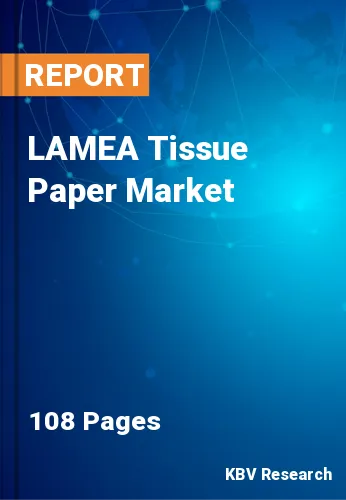The Latin America, Middle East and Africa Tissue Paper Market would witness market growth of 5.2% CAGR during the forecast period (2023-2030).
Innovations in the materials and technologies utilized in the final product are crucial to advancing retail hygiene products. In the context of nonwovens' hygiene aspect, significant innovations have enhanced the functionality and suppleness of numerous product categories. Typically, spun lace nonwoven fabrics are utilized in the infant diaper industry. Recently, they have expanded into additional markets, including adult incontinence, infant diapers, and feminine hygiene products. Spunlace is now a more cost-effective option for sanitary product manufacturers due to efficient production methods.
In recent years, the demand for sanitation products has witnessed the introduction of novel infant care and adult incontinence products equipped with ubiquitous sensor technology. The objective is to enhance user comfort and prevent epidermis issues. Typically, these technologies emit an alarm when a diaper needs to be changed or adult incontinence happens.
Companies are implementing various technological advances into their designs to offer people linens and sanitary products that are gentler and more absorbent. Bunzl R3 introduced an innovative, extensive array of multi-foldable and distinctively shaped towels, napkins, and other consumables to provide clients with high-quality hygienic products.
As countries such as Africa are water-scarce, LAMEA is a lucrative hub for manufacturers and suppliers of moist tissues. Due to this, the regional population would welcome introducing products that eliminate the need for water to clean and sanitize their bodies, workplaces, and other surfaces. In addition, South Africa is home to many manufacturing facilities capable of producing paper-based moist wipes in countries such as Chile, Peru, Argentina, and Brazil.
Furthermore, the intimate hygienic tissues were designed to protect a woman's sensitive private areas. Despite feminine hygiene wipes are relatively new to the market, their benefits for improved quality of life have been widely acknowledged by women who use them for cleanliness and convenience. Consequently, these factors will likely create new growth opportunities for the regional market throughout the forecast period.
The Brazil market dominated the LAMEA Tissue Paper Market by Country in 2022, and would continue to be a dominant market till 2030; thereby, achieving a market value of $509.4 Million by 2030. The Argentina market is anticipated to grow at a CAGR of 5.7% during (2023 - 2030). Additionally, The UAE market would exhibit a CAGR of 4.9% during (2023 - 2030).
Based on Application, the market is segmented into At Home, and Away From Home. Based on Product Type, the market is segmented into Paper Tissues (made from pulp), Facial Tissue, Wet Wipes, and Others. Based on Distribution Channel, the market is segmented into Offline, and Online. Based on countries, the market is segmented into Brazil, Argentina, UAE, Saudi Arabia, South Africa, Nigeria, and Rest of LAMEA.
Free Valuable Insights: The Worldwide Tissue Paper Market is Projected to reach USD 25.1 Billion by 2030, at a CAGR of 3.2%
The market research report covers the analysis of key stake holders of the market. Key companies profiled in the report include The Procter and Gamble Company, Georgia-Pacific LLC (Koch Industries, Inc.), Kruger Inc., Kimberly-Clark Corporation, Essity AB, Naturelle Consumer Products Ltd, Solaris Paper, Inc., Seventh Generation, Inc. (Unilever PLC), Hengan International Group Company Limited, Asia Pulp and Paper Group Sinar Mas
By Application
By Product Type
By Distribution Channel
By Country
Our team of dedicated experts can provide you with attractive expansion opportunities for your business.

